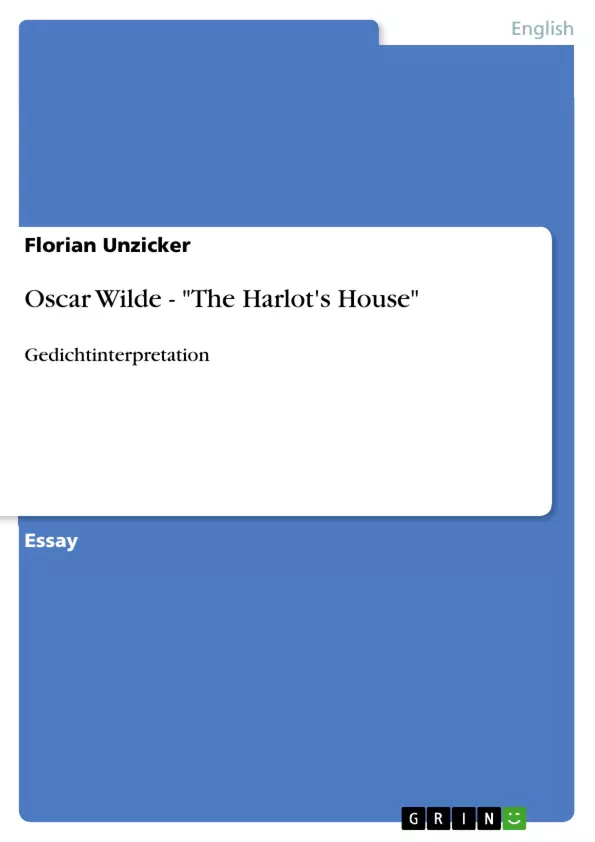Gedichtinterpretation von Oscar Wilde's "The Harlot's House"
This paper wants to examine Oscar Wilde’s poem “The Harlot’s House”. For that purpose, two steps seem necessary to me. Initially, the prosodic, metric and rhetorical elements and figures should be analysed in a sort of “survey” to get a first approach to the poem. Building on these observations, an interpretation will be attempted.
Inhaltsverzeichnis (Table of Contents)
- Introduction
- Analysis of Prosodic, Metric, and Rhetorical Elements
- Nocturnal Setting and Initial Perceptions
- Voyeuristic Glimpse and Grotesque Scenery
- Dissolution of Solidarity and Entrance into the House
- Dawn and Contrast
- Stylistic Features
- Alliteration and Synaesthesia
- French Words and Aesthetic Quality
- Semantic Fields: Decay and Death, Mechanics, Music and Dance
- Contrasts and Interpretation
Zielsetzung und Themenschwerpunkte (Objectives and Key Themes)
This paper aims to analyze Oscar Wilde's poem "The Harlot's House," initially examining its prosodic, metric, and rhetorical elements before moving toward interpretation. The analysis will explore the poem's structure, language, and imagery to shed light on its meaning.
- The contrast between romantic love and the artificiality of the brothel
- The exploration of themes of death, decay, and artificiality
- The use of stylistic devices such as alliteration, synaesthesia, and French vocabulary
- The poem's presentation of Victorian societal views on love and sexuality
- The impact of sensory perceptions on the poem's overall effect
Zusammenfassung der Kapitel (Chapter Summaries)
The introduction outlines the paper's methodology: a close reading focusing on formal elements followed by interpretation. The analysis of prosodic features details the poem's regular structure, rhyme scheme, and meter, highlighting exceptions that contribute to the poem's effect. The initial section then describes the poem's nocturnal setting and the couple's initial observations of the brothel, emphasizing the contrast between the romantic atmosphere and the sounds emanating from within. The next section focuses on the couple's voyeuristic observation of the bizarre and lifeless scene inside the brothel, highlighting the imagery of shadows, skeletons, and mechanical movements. The following part examines the dissolution of the couple's solidarity, with the woman's fascination with the music leading her to enter the brothel. This event disrupts the harmony and causes a noticeable change in the atmosphere of the house. The final analyzed section describes the arrival of dawn and contrasts it with the nocturnal setting of the brothel, using the shortened meter of the final line to underscore this contrast. The stylistic analysis explores prominent features such as alliteration and synaesthesia, the use of French words, and the different semantic fields present within the poem, each contributing to the overall atmosphere of the poem.
Schlüsselwörter (Keywords)
Oscar Wilde, The Harlot's House, Victorian poetry, symbolism, imagery, prosody, meter, rhetoric, alliteration, synaesthesia, death, decay, artificiality, love, sexuality, social conventions, French language, mechanical imagery.
- Quote paper
- Florian Unzicker (Author), 2007, Oscar Wilde - "The Harlot's House", Munich, GRIN Verlag, https://www.grin.com/document/122627



